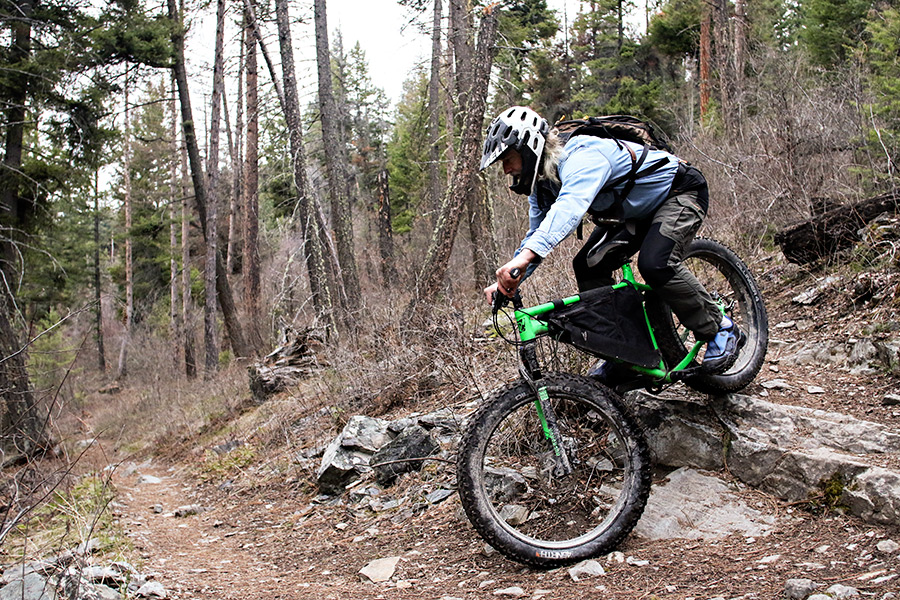The age-old debate over whether mountain bikes should be allowed in designated wilderness areas is heating up again as new legislation is expected to surface in Congress over the next month seeking to change the bedrock environmental law.
A national mountain-biking group called Sustainable Trails Coalition has drafted a bill — the Human-Powered Wildlands Travel Management Act of 2015 — that would give local land managers, such as U.S. Forest Service supervisors, the ability to decide whether riders can use sections of trail in designated wilderness areas, whether for recreational riding or for trail maintenance and other work using wheeled tools.
The debate over bikes in protected wilderness has intensified in the decades since 1984, when the Forest Service explicitly outlawed “mechanized transport” in those areas.
The original Wilderness Act of 1964 stated, “there shall be … no use of motor vehicles, motorized equipment or motorboats, no land of aircraft, no other form of mechanical transport, and no structure or installation within any such area.” At the time, mountain biking was unheard of; yet by 1984 the sport was in its infant stages as a growing popular activity, and Wilderness Society, the Sierra Club and other conservation groups convinced the Forest Service to broaden the wilderness prohibition from motorized to mechanized transport, effectively outlawing bikes.
Today, the popularity of mountain biking has ballooned — an estimated 40 million people participate in the activity annually, according to a survey by the Outdoor Industry Foundation. At the same time, the amount of designated wilderness has grown to over 109 million acres across the U.S., including over 3.4 million in Montana.
Last week, as the bill awaits a sponsor in Congress, a group of 116 conservation organizations from across the U.S., including 13 from Montana, published a letter asking lawmakers to reject any proposed changes that would allow bikes in the wilderness.
The collective, which includes local Swan View Coalition, North Fork Preservation Association and Friends of the Wild Swan, said in its letter, “For over a half century, the Wilderness Act has protected wilderness areas designated by Congress from mechanization and mechanical transport, even if no motors were involved with such activities. This has meant, as Congress intended, that Wildernesses have been kept free from bicycles and other types of mechanization and mechanical transport.”
The groups contend that the stated purpose of the Wilderness Act is, in part, to protect areas from “expanding settlement and growing mechanization,” as the law states.
“At a time when wilderness and wildlife are under increasing pressures from increasing populations, growing mechanization, and a rapidly changing climate, the last thing Wilderness needs is to be invaded by mountain bikes and other machines,” stated George Nickas, executive director of Wilderness Watch.
The International Mountain Bicycling Assocation (IMBA), the leading mountain biking advocacy group, has not publically opposed the ban, instead focusing its efforts on pushing for boundary changes and alternative designations that still allow bikes.
The issue has come to the fore recently after recent changes in the Kootenai National Forest, where the Forest Service is proposing the Ten Lakes Wilderness Study Area. By designating an area as Wilderness Study or Recommended Wilderness, the agency could still maintain prohibitions from within the Wilderness Act for biking and snowmobiling.
Last winter a group of snowmobile organizations sued the Forest Service claiming it lacks clear rules or guidelines for defining potential wilderness areas, especially in an area that has historically allowed snowmobiling and mountain biking, such as Ten Lakes on the northern section of the Whitefish Range east of Eureka.
Mountain biking enthusiasts see this as further evidence for why riding should be allowed in certain forest labyrinths. Supporters cite research that shows riding on trails has the same environmental impact as hiking. Ted Stroll, the author of the Wildlands bill and head of the Sustainable Trails Coalition, says the draft legislation is not seeking a universal acceptance for bikes; instead, it would open the door for local managers to consider corridors where bikes on trails could be appropriate.
“We keep hearing that we’d be weakening the Wilderness Act and paving the way for things like mining and motorcycles in Wilderness,” Stroll told Outside Magazine this winter. “No congressional office we’ve talked with wants to do anything more than we want to—allow cyclists back onto some trails in some Wilderness areas and the PCT. Second, this domino-theory argument is regularly trotted out by people who oppose any kind of societal change.”
Locally, Ron Cron, a well-known mountain biking advocate in the Flathead Valley, is optimistic that this latest push for wilderness access could gain traction. Cron rides every weekend and volunteers to maintain trails on the Flathead National Forest, especially Crane Mountain near Bigfork.
Cron said he has been discouraged by recent decisions by the Forest Service in regards to mountain biking on public lands but he hopes that the agency and residents will realize that it could benefit both trail maintenance and those seeking a healthy outdoor activity.
“It’s not about letting bikes back in the wilderness. It’s about giving local land managers the flexibility to allow bikes for even their own people to go in to maintain wilderness trails,” Cron said. “What harm is a bike going to do to those trails? “
